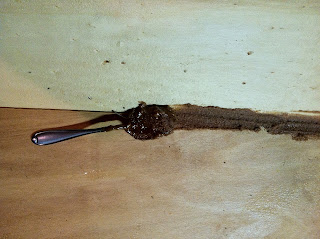I was aware of this earlier, but I made a mistake in cutting my boards. The bottom pieces were an inch or two short. Because of this I had to deviate from the directions a little bit when joining the two hulls. I was supposed to have a nice flush seam on the bottom and both sides, however when I lined up the bottoms of the canoe, the sides overlapped by a couple inches. I decided to run with it and just have overlapping sides on the canoe. The plywood is thin enough that this shouldn't make a huge difference. I used "butt blocks" on the bottom of the canoe to hold the two hulls together. Butt blocks are just boards that lay over the two pieces of plywood and span the seam. I glued the but blocks on and the sides together at the overlap. I weighted it down to make sure the glue stuck and put clamps on the sides. For glue, I am using an epoxy resin. The resin I chose 4 years ago, or possibly because it's 4 years old, takes a very long time to cure. It takes about a week to fully cure and at least 48 hours before it's not too sticky.

After gluing the hulls together, I started tightening the seams. My friend Jay helped out this day. Having another person is really useful when handling the canoe at this stage. We flipped the hull over to check for straightness. There was a little bit of a curve that I tried to fix by adjusting the wire ties. My biggest concern is twist in the hull. Any twist will make the canoe not paddle straight, which could be irritating. However since this is my first attempt at anything like this, I have no idea how sensitive the canoe's glide is to any asymmetry.


With the hull in pretty good shape, it was time to start gluing the inside seams and laying down the fiberglass tape. It is very hard to put tape and resin into seams with cracks or sharp angles, so before doing so you fillet the seam. My instructions were about that descriptive. Filleting the seam means mixing epoxy resin and wood flour into a peanut butter like paste. Wood flour is very fine sawdust that is the product of sanding. Most sanders have a little bag in which they vacuum the fine saw dust. I emptied ours and made some fillet. Over the fillet I put fiberglass cloth which turns transparent when you add epoxy. My sanders didn't have much wood flour however, and I quickly ran out. I am currently experimenting with some courser sawdust to see if that will work. Otherwise, I'll have to purchase some wood flour.








.JPG)

.JPG)
.JPG)
.JPG)
.JPG)
.JPG)
